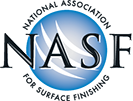| Presented in Partnership with: | |||
 |
 |
 |
 |
Mr. George G. Saleh
Zoom Environmental Services, Inc.
2131 Hidden Trail Drive
Sterling Heights, MI 48314Dear Mr. Saleh:
This is a follow up to my letter of February 20, 1998 acknowledging receipt of your January 31, 1998 letter requesting an alternative to Method 306B (40 CFR 63, Appendix A) for measuring surface tension in a chrome plating tank.
As mentioned in the initial correspondence, I tried to obtain method performance information (precision and bias data) for the "Capillary Tube Surface Tension Apparatus", Unit No. 14-818. I contacted Fisher Scientific for possible information. Fisher referred me to Mr. Dotterweick, (973) 335-5191 of "Q" Glass Company, Inc., 624 Route 202, Towaco, NJ 07082.
Mr. Dotterweick, who is the manufacturer of the unit, stated that he could only provide basic operating instructions for the apparatus. He further stated that as far as he knew, no method performance data had ever been developed for the apparatus. Also, there is no mention of the proposed apparatus in the ASTM procedure D 1331-89, "Standard Test Methods for Surface and Interfacial Tension of Solutions of Surface-Active Agents" referenced in Method 306B.
As we can find no method performance data for evaluating your request, it becomes your responsibility as the requestor to provide essential technical information required to make the comparison. Therefore, as stated in our prior correspondence, the precision and bias for the proposed method will have to be evaluated directly by comparing results generated by the proposed method to those of Method 306B.
The method evaluation will have to follow the protocol described in Section 5.2 of EPA Method 301 (40 CFR Part 63, Appendix A). This will require analysis of six different samples, two times each using Method 306B and two times each using your proposed method. This operation is then to be followed by the statistical analysis described in Section 6.2.2 of Method 301.
I am enclosing a paper entitled, "Report on Observed Differences in Dynes/Centimeter Readings of Various Chromium MACT Method 306B Surface Tension Measuring Devices". The paper summarizes evaluation data for the two surface tension measuring devices cited in Method 306B: stalagmometer and precision tensiometer. The major conclusions are: 1) tensiometers are the preferred measuring device for chromic acid-mist suppressant solutions, 2) stalagmometers produce a higher surface tension measurement than tensiometers when measuring suppressant solutions with a difference of up to 33 dynes/cm at ~40dynes/cm, 3) the surface tension of acid-mist suppressants does not decrease with increasing temperature as it does with water, and 4) surface tension measurements should be performed at the same temperature for reproducible results. The direct comparability difference between the two measuring devices means that more chemical suppressant must be added when conducting surface tension measurements with a stalagmometer. When selecting which approved measurement device to compare to the proposed method, we recommend that you use the tensiometer. Comparing the proposed method to the stalagmometer may require that additional suppressant be added when in fact it is not needed. In addition, it has been reported that the stalagmometer is labor intensive and time-consuming (3 - 5 minutes per measurement). We currently expect to reevaluate the use of the stalagmometers for performing chemical suppressant surface tension measurements during the next several months.
Also enclosed is a copy of a March 30, 1993 memorandum from Mr. Gilbert Wood entitled, "Handling Requests for Minor/Major Modifications/Alternative Testing and Monitoring Methods or Procedures Approvals and Disapprovals" as well as a copy of Method 301 for your use in obtaining and submitting the required information. You may want to contact your industry association for assistance, as the final information may benefit other association members as well as yourself.
Should you desire further discussion or clarification of the approval process, please contact me at U.S. Environmental Protection Agency, Mail Drop 19, Research Triangle Park, North Carolina 27711, Telephone No. (919) 541-5239.
Sincerely,
Clyde E. Riley
Emission Measurement Center
cc: William Lamason, EPA, OAQPS (MD-19)
Robin Segall, EPA, OAQPS (MD-19)
Latit Banker, EPA OAQPS (MD-13)
Scott Throwe EPA, OECA
Kim Armbruster Michigan Department of Environmental Quality
Diane Kavanaugh Michigan Department of Environmental QualityEnclosures (3)
 |
 |
 |
 |
 |
| Home | Subscribe | Regulations | Compliance Assistance | News | Resources | Resource Locators | Directories | Online Training | About | Search | NASF.org |
The information contained in this site is provided for your review and convenience. It is not intended to provide legal advice with respect to any federal, state, or local regulation.
You should consult with legal counsel and appropriate authorities before interpreting any regulations or undertaking any specific course of action.
Please note that many of the regulatory discussions on STERC refer to federal regulations. In many cases, states or local governments have promulgated relevant rules and standards
that are different and/or more stringent than the federal regulations. Therefore, to assure full compliance, you should investigate and comply with all applicable federal, state and local regulations.